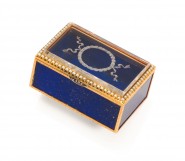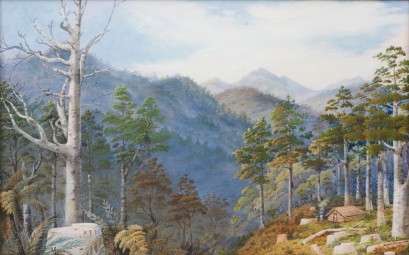Lot #44 - Alfred Sharpe
-
Auction House:Webb's
-
Sale Name:Important Paintings and Contemporary Art
-
Sale Date:06 Dec 2011 ~ 6.30pm (NZ Time)
-
Lot #:44
-
Lot Description:Alfred Sharpe
Alfred Sharpe, Kauri Logging on the Coromandel, 1882 Painted in 1882, Alfred Sharpe's Kauri Logging on the Coromandel is a valuable historica
watercolour on paper
600mm x 900mm
signed Alfred Sharpe and dated 1882 in brushpoint lower right -
References:Blackley, Roger. The Art of Alfred Sharpe. Auckland City Art Gallery/David Bateman Ltd, Auckland, 1992, p. 69.
-
Notes:Alfred Sharpe, Kauri Logging on the Coromandel, 1882 Painted in 1882, Alfred Sharpe's Kauri Logging on the Coromandel is a valuable historical document that bears witness to the logging of native timber in New Zealand during the colonial period. Like most of Sharpe's watercolours, Kauri Logging on the Coromandel is executed with an almost photographic veracity that is achieved through the use of tightly controlled brush strokes, sharp focus and saturated colours. The barely perceptible strokes of Sharpe's brush coupled with the clear, all-over lighting, the use of atmospheric perspective and the firmly structured composition pay tribute to Sharpe's mastery of the watercolour medium. Although, like the majority of Sharpe's paintings, Kauri Logging on the Coromandel offers a high level of detail, Sharpe's sophisticated watercolour technique nevertheless allows for the viewer to take in the overall essence of the scene without being distracted or inundated by the mimesis of his chosen tableau. The majority of Kauri Logging on the Coromandel is taken up with the accurate portrayal of the topography of the kauri forests of the Coromandel. Majestic kauri trees flank the foreground of the work and extend back into the picture plane where they are seen blanketing the rolling hills in the middle distance. Evidence of human industry is seen in the small wooden hut and curling tendril of smoke, which are dwarfed by the surrounding forest. Future human dominance is, however, indicated by the large ominous kauri stump in the right-hand foreground. This, in turn, is echoed by the scattering of stumps to the left, which together bear witness to the inevitability of fallen trees and barren hills. These pale, white, ghostly forms render the remainder of the forest fragile and vulnerable. Sharpe's distinctive ability to build and present to the viewer a balanced equilibrium between man and nature is clearly illustrated in Kauri Logging on the Coromandel. Here, the artist records the tracts of remote native forest that spilt out across the Coromandel and pays tribute to the untouched paradise of New Zealand. This extensive and seemingly timeless idyll is, however, subtly undercut by Sharpe's documentation of the signs of human progress. By reducing the physicality of human endeavour though, Sharpe accords the dignified splendour of the New Zealand woodland centre stage. As a result, Sharpe is able to produce a painting that is compositionally and chromatically appealing without sacrificing his factual objectivity. The number of topographical watercolours that Sharpe produced during his time in Auckland during the 1870s and 1880s collectively attests to a landscape that has been irrevocably lost and to an artist who had a supreme command of watercolour and an eye for his and his mastery of colour . As such, Kauri Logging on the Coromandel from 1882 is an historically valuable watercolour that evidences the now-lost kauri forests of the Coromandel prior to the extensive logging that was carried out by the colonial settlers throughout the closing decades of the 19th century. JEMMA FIELD
-
Estimate:NZ$80,000 - 120,000
-
Realised Price:
-
Category:Art
This Sale has been held and this item is no longer available. Details are provided for information purposes only.










